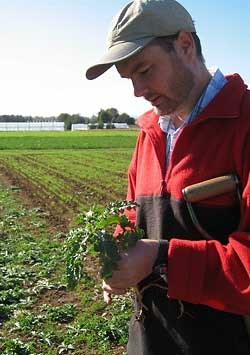
Richard G. Smith
I'm an agroecologist working at the interface between plant community ecology and agriculture. My research interests involve weed ecology and management, the role of diversity in agroecosystem function, plant invasions, community assembly theory, and trophic interactions. The overall goal of my research is to better understand the ecological interactions that underpin agricultural production systems so as to improve the economic and environmental sustainability of agriculture.
My work here at Penn State is focused mainly on understanding and addressing weed management, environmental quality, and profitability issues in organic feed and forage production systems typical of the mid-Atlantic region. I am also developing research aimed at assessing the role of cropping system diversity in mediating weed-crop competition. Prior to coming to Penn State, I was a Research Ecologist with the USDA-ARS, Exotic and Invasive Weeds Research Unit in Albany, CA (2006-2008) and a Postdoctoral Research Associate in the Department of Land Resources and Environmental Sciences at Montana State University (2005-2006). My Ph.D. research was conducted at Michigan State University's W.K. Kellogg Biological Station (1999-2005), and focused on the role of crop diversity in weed community assembly and agroecosystem function. My undergraduate degree (B.S. in biology) was attained at the University of New Mexico (1992-1996).
Much of my worldview has been shaped by my experiences as a Peace Corps volunteer in Papua New Guinea (1997-1999) and my childhood growing up on the Navajo Reservation in northwest New Mexico.
My free time is happily occupied by my four-year-old daughter Sydney and explorations of beautiful central Pennsylvania.
Publications
- Smith, R.G., M.R. Ryan, and F.D. Menalled. 2010. Direct and indirect impacts of weed management practices on soil quality. In: J. Hatfield and T. Sauer (Eds.) Soil Management: Building a Stable Base for Agriculture. American Society of Agronomy Series. In Press.
- Gareau, T.L.P., R.G. Smith, M.E. Barbercheck, and D.A. Mortensen, DA. 2010. Spider plots: a tool for participatory extension learning. Journal of Extension. In Press.
- Smith, R.G., D.A. Mortensen, and M.R. Ryan. 2010. A new hypothesis for the functional role of diversity in mediating resource pools and weed-crop competition in agroecosystems. Weed Research 50: 37-48.
- Ryan, M.R., R.G. Smith, D.A. Mortensen, J.R. Teasdale, W.S. Curran, and R. Seidel. 2009. Weed-crop competition relationships differ between organic and conventional cropping systems. Weed Research 49: 572-580.
- Smith, R.G., R. Jabbour, A.G. Hulting, M.E. Barbercheck, and D.A. Mortensen. 2009. Effects of initial seed bank density on weed seedling emergence during the transition to an organic feed grain crop rotation. Weed Science 57: 533-540.
- Davis, A.S., J.C. Hall, M. Jasieniuk, M.A. Locke, E.C. Luschei, D.A. Mortensen, D.E. Riechers, R.G. Smith, T.M. Sterling, and J.H. Westwood. 2009. Weed science research and funding: a call to action. Weed Science 57: 442-448.
- Smith, R.G., K.L. Gross, and G.P. Robertson. 2008. Effects of crop diversity on agroecosystem function: crop yield response. Ecosystems 11: 355-366.
- Smith, R.G., C.P. McSwiney, A.S. Grandy, P. Suwanwaree, R.M. Snider, and G.P. Robertson. 2008. Diversity and abundance of earthworms across an agricultural land-use intensity gradient. Soil & Tillage Research 100: 83-88.
- Smith, R.G., F.D. Menalled, and G.P. Robertson. 2007. Temporal yield variability under conventional and alternative management systems. Agronomy Journal 99: 1629-1634.
- Maxwell, B.D., R.G. Smith, and M. Brelsford. 2007. Wild oat (Avena fatua) seed bank dynamics in transition to organic wheat production systems. Weed Science 55: 212-217.
- Smith, R.G. and K.L. Gross. 2007. Assembly of weed communities along a crop diversity gradient. Journal of Applied Ecology 44: 1046-1056.
- Menalled, F.D. and R.G. Smith. 2007. Competitiveness of herbicide resistant and susceptible kochia (Kochia scoparia (L.) Schrad.) under contrasting management practices. Weed Biology and Management 7: 115-119.
- Menalled, F.D., R.G. Smith, J.T. Dauer, and T.B. Fox. 2007. Impact of agricultural management on carabid communities and weed seed predation. Agriculture, Ecosystems, and Environment 118: 49-54.
- Smith, R.G. and K.L. Gross. 2006. Rapid change in the germinable fraction of the weed seed bank in crop rotations. Weed Science 54: 1094-1100.
- Smith, R.G., B.D. Maxwell, F.D. Menalled, and L.J. Rew. 2006. Lessons from agriculture may improve the management of invasive plants in wildland systems. Frontiers in Ecology and the Environment 4: 428-434.
- Smith, R.G. 2006. Timing of tillage is an important filter on the assembly of weed communities. Weed Science 54: 705-712.
- Smith, R.G. and K.L. Gross. 2006. Weed community and corn yield variability in diverse management systems. Weed Science 54: 106-113.
- Smith, R.G., K.L. Gross, and S. Januchowski. 2005. Earthworms and weed seed distribution in annual crops. Agriculture, Ecosystems and Environment 108: 363-367.

